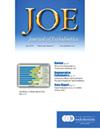Influence of the Filling Technique on Endodontic Retreatment in Curved Mesial Canals of Mandibular Molars: An In Vitro Study
IF 3.5
2区 医学
Q1 DENTISTRY, ORAL SURGERY & MEDICINE
引用次数: 0
Abstract
Introduction
The root curvature represents a challenge during the endodontic retreatment. Considering the different techniques to fill the root canals and the growing use of bioceramic sealers, this study aimed to evaluate the influence of the filling technique associated with a bioceramic sealer on the remaining filling material and the impact on the remaining dentin after the filling removal in the retreatment of curved mesial canals of mandibular molars.
Methods
Eighteen curved mesial roots of mandibular molars with Vertucci type IV canals were prepared up to instrument 35/.05. Two groups were established according to the filling technique: single-cone (n = 18) and continuous wave of condensation (n = 18). Bio-C Sealer was used for both techniques. The filling was removed using the Reciproc Blue R25 instrument, and the repreparation was carried out using the Reciproc Blue R40 instrument. The samples were scanned by micro–computed tomography before and after the filling removal and analyzed regarding the volume of the remaining filling material and dentin thickness for calculating transportation and centering ability. For statistical analysis, the data normality was checked, and parametric tests were used for normal distribution and nonparametric tests for nonnormal distribution.
Results
The remaining filling material was observed in both groups during retreatment, with no differences. Analyses of transportation and centering ability also indicated similarities between the two groups.
Conclusions
Endodontic retreatment in curved mesial canals of mandibular molars filled with single-cone or continuous wave of condensation technique and bioceramic sealer was similar. The use of reciprocating instruments for filling removal and repreparation was efficient in curved mesial canals of mandibular molars, with no complications.
充填技术对下颌磨牙弯曲近中管根管再治疗影响的体外研究。
在根管再治疗中,根弯曲是一个挑战。考虑到不同的根管充填技术和生物陶瓷填充物的使用日益增多,本研究旨在评估生物陶瓷填充物对下颌磨牙弯曲近中根管再治疗中剩余填充物的影响以及填充物去除后对剩余牙本质的影响。方法:采用Vertucci IV型牙根管制备下颌磨牙弯曲近中根18根。按充填方式分为两组:单锥充填组(n=18)和连续波充填组(n=18)。两种技术均使用Bio-C Sealer。使用Reciproc Blue R25器械去除填充物,使用Reciproc Blue R40器械进行再准备。在填充物去除前后对样品进行micro-CT扫描,分析剩余填充物体积和牙本质厚度,计算运输和定心能力。统计分析采用数据正态性检验,正态分布采用参数检验,非正态分布采用非参数检验。结果:两组再治疗时均观察到充填物剩余量,无差异。交通和定心能力的分析也显示了两组之间的相似性。结论:下颌磨牙弯曲近中根管再治疗采用单锥或连续波充填技术与生物陶瓷充填技术效果相似。在弯曲的下颌磨牙近中牙管中使用往复器械进行补牙清除和再准备是有效的,无并发症。
本文章由计算机程序翻译,如有差异,请以英文原文为准。
求助全文
约1分钟内获得全文
求助全文
来源期刊

Journal of endodontics
医学-牙科与口腔外科
CiteScore
8.80
自引率
9.50%
发文量
224
审稿时长
42 days
期刊介绍:
The Journal of Endodontics, the official journal of the American Association of Endodontists, publishes scientific articles, case reports and comparison studies evaluating materials and methods of pulp conservation and endodontic treatment. Endodontists and general dentists can learn about new concepts in root canal treatment and the latest advances in techniques and instrumentation in the one journal that helps them keep pace with rapid changes in this field.
 求助内容:
求助内容: 应助结果提醒方式:
应助结果提醒方式:


